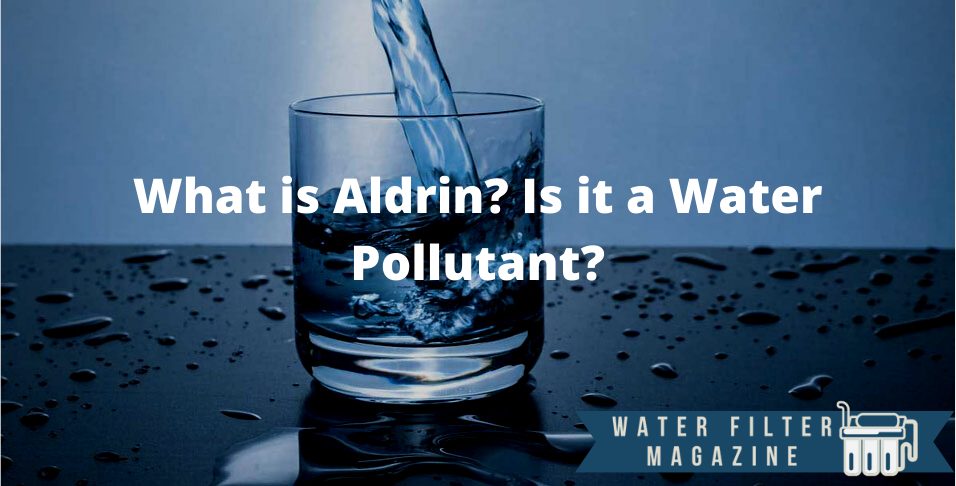Aldrin is a chlorinated pesticide used against soil-dwelling pests and for wood protection. Aldrin is readily converted to Dieldrin (another chlorinated pesticide) in the environment and the body. Aldrin and Dieldrin, both manufactured since 1950, were used throughout the world until the early 1970s when they were banned in most countries. In the USA, the U.S. Environmental Protection Agency (EPA) banned all uses of Aldrin and Dieldrin in 1974 (except to control termites). The EPA banned all applications in 1987. However, Aldrin production and use continued in some countries.
Aldrin is a water pollutant. The acceptable daily intake (ADI) is defined as the maximum amount of a chemical to which a person can be exposed daily over an extended time without suffering a harmful effect. The ADI for Aldrin is 0-0.0001 mg/kg (0-0.1 μg/kg) of body weight.
What is Aldrin Used for?
Aldrin is very effective as a soil pesticide and has been used to treat seeds. Aldrin controls termites, corn rootworms, seed corn beetles, seed corn maggots, wireworms, rice water weevil, grasshoppers, and Japanese beetles. In addition, Aldrin is useful for the protection of wooden structures in buildings from termites.
What are the Characteristics of Aldrin?
Aldrin is an organochlorine pesticide widely used in the United States until 1974 when the EPA banned it for most purposes. Aldrin (and its oxidation product Dieldrin), are persistent pollutants because they degrade very slowly in the environment. Aldrin is slightly soluble in water but very soluble in organic solvents and fats. Some identifiers of Aldrin are CAS Number 309-00-2 (Chemical Abstracts Service), ChemSpider 10292747 (Royal Society of Chemistry), and PubChem CID 2087 (National Center for Biotechnology Information). In these databases, additional information may be found.
The following table shows essential characteristics of Aldrin:
| Properties of Aldrin | |
| Molecular formula | C12H8Cl6 |
| Molecular weight | 364.90 |
| Appearance | Colorless solid |
| Density | 1.60 g/mL |
| Melting point | 104°C (219°F) |
| Boiling point | 145°C @ 2 mmHg |
| Water solubility | Slightly soluble |
| Vapor pressure | 7.5 × 10−5 mmHg @ 20°C |
Aldrin’s very low water solubility makes it very persistent in soils.
How does Aldrin contaminate water?
 Aldrin (and its reaction product, Dieldrin) contaminate groundwater primarily by runoff from agricultural fields and urban areas where they are applied. Also, Aldrin contamination may occur on soil from the atmosphere by precipitation and dry deposition, from there reaching groundwater.
Aldrin (and its reaction product, Dieldrin) contaminate groundwater primarily by runoff from agricultural fields and urban areas where they are applied. Also, Aldrin contamination may occur on soil from the atmosphere by precipitation and dry deposition, from there reaching groundwater.
What is the most convenient water filtration system for filtering Aldrin?
The most effective water filtration systems for filtering Aldrin use a combination of reverse osmosis (R.O.) and carbon filters. R.O. uses membranes that filter specific ions and impurities. The most convenient systems for filtering Aldrin include an activated carbon water filter. Activated carbons have great surface areas, where impurities like Aldrin are attracted and fixed. Different types of activated carbons are available, including granular activated carbon
(GAC) and block activated carbon. Block activated carbon is more compact. Thus, it is a more effective filter against Aldrin. However, it needs higher water pressure.
Can every water filter system clean the Aldrin from water?
Yes, various types of water filters can clean Aldrin (and Dieldrin) with high levels of success. Reported efficiencies of different water filtration systems against Aldrin are given below.
- Reverse Osmosis (R.O.) filters remove 99-100 % of pesticides. R.O. filters may use different membrane types to filter particles and big molecules; The most common types are the thin film composite (TFC or TFM) and the cellulose triacetate (CTA) membrane.
- Activated Carbon (A.C.) filters remove 99% of Aldrin. Activated carbon traps many types of organic molecules (including pesticides) by a physical process called adsorption, where the molecules are attracted to the A.C. surface. The A.C.s surfaces have great areas where the molecules are retained.
Is Aldrin toxic for humans?
Yes, Aldrin is toxic for humans. Aldrin intoxication may include headache, dizziness, nausea, general malaise, and vomiting, followed by muscle twitching, myoclonic jerks, and convulsions. Aldrin is also toxic for mammals and highly toxic for fish.
What is the toxicity level of Aldrin?
The acceptable daily intake (ADI) is defined as the maximum amount of a chemical to which a person can be exposed daily over an extended time without suffering a harmful effect. From 1966 onwards, the JMPR (FAO/WHO Joint Meeting on Pesticide Residues) established an ADI of 0-0.0001 mg/kg (0-0.1 μg/kg) of body weight (combined total for Aldrin + Dieldrin). The toxic levels of concern for Aldrin are 0-0.0001 mg/kg (0-0.1 μg/kg) of body weight, daily.
Is it safe to have Aldrin in drinking water?
No, Aldrin is not safe to consume in drinking water. Estimates for the lowest human lethal dose of Aldrin range between 1.25 and 10 mg/kg. WHO recommends the concentration of Aldrin in water be less than 0.03 mg/L.
What are the effects of Aldrin when consumed in drinking water?
 The effects of Aldrin when consumed in excessive amounts may involve headache, dizziness, hyperirritability, malaise, nausea and vomiting, anorexia, muscle twitching, and myoclonic jerking prior to the development of seizures. Renal dysfunction followed acute ingestion of aldrin. This resulted in elevated blood urea nitrogen, gross hematuria, and albuminuria. However, for a group of workers subjected to long-term exposure to Aldrin, central nervous system symptoms subsided within a few weeks when Aldrin exposure was stopped.
The effects of Aldrin when consumed in excessive amounts may involve headache, dizziness, hyperirritability, malaise, nausea and vomiting, anorexia, muscle twitching, and myoclonic jerking prior to the development of seizures. Renal dysfunction followed acute ingestion of aldrin. This resulted in elevated blood urea nitrogen, gross hematuria, and albuminuria. However, for a group of workers subjected to long-term exposure to Aldrin, central nervous system symptoms subsided within a few weeks when Aldrin exposure was stopped.
What is the possible health risk of Aldrin?
Aldrin is found to be highly toxic in experimental animals. Cases of Aldrin poisoning (including fatalities) have occurred in humans. The target organs of Aldrin poisoning are the central nervous system and the liver. The effects of Aldrin (and its transformation product, Dieldrin) have been studied in humans and animals. The health risks of Aldrin when consumed in drinking water are summarized below.
- Cancer: The IARC (International Agency for Research on Cancer) of the WHO classifies Aldrin as an agent “with limited evidence in humans” for inducing cancer in the female breasts. In animal assays, however, an increased incidence of hepatic tumors was detected. EPA’s Integrated Risk Information System (IRIS) classifies Aldrin and Dieldrin as B2 (probable human carcinogen).
- Liver Lesions: Liver lesions were found in animal studies (rats and dogs) (EPA). However, there is no information about liver diseases for humans.
- Renal dysfunction.
Is Aldrin more toxic than the other Water Contaminants?
Yes, Aldrin is more toxic than many common water contaminants. Unlike Chlorine, Chloride, and Fluoride, which are beneficial in certain concentrations (but toxic at high concentrations), Aldrin is not beneficial for human consumption. Also, the Acceptable Daily Intake (ADI) for Aldrin is lower than for Arsenic, Chromium, or Lead, which are toxic substances included in the contaminant candidate list.
Does Well Water contain Aldrin?
Yes, well water may contain Aldrin (and/or Dieldrin), because Aldrin is converted to Dieldrin in the environment, and both are persistent. If the presence of Aldrin or Dieldrin is suspected, the concentration should be checked by a certified laboratory.
However, from State and regional studies and the EPA Databases, it was found that the occurrence of Aldrin or Dieldrin in drinking water at frequencies or concentrations significant for public health concerns is low. Also, according to a recent EPA report, Aldrin and Dieldrin were found in very few wells and in low concentrations.

